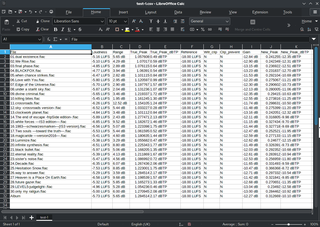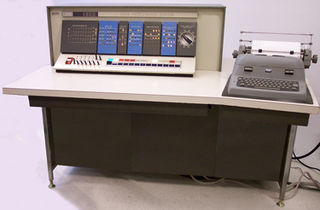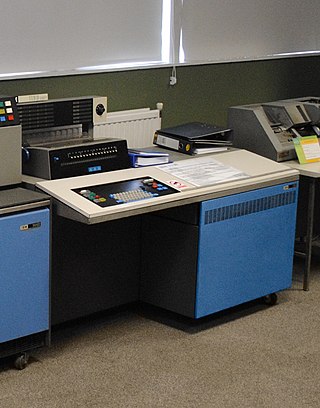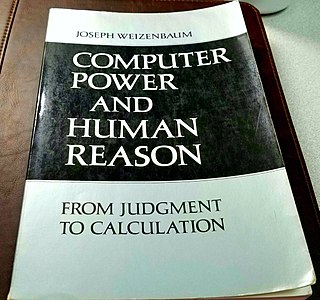Related Research Articles

A computer program is a sequence or set of instructions in a programming language for a computer to execute. It is one component of software, which also includes documentation and other intangible components.

ELIZA is an early natural language processing computer program developed from 1964 to 1967 at MIT by Joseph Weizenbaum. Created to explore communication between humans and machines, ELIZA simulated conversation by using a pattern matching and substitution methodology that gave users an illusion of understanding on the part of the program, but had no representation that could be considered really understanding what was being said by either party. Whereas the ELIZA program itself was written (originally) in MAD-SLIP, the pattern matching directives that contained most of its language capability were provided in separate "scripts", represented in a lisp-like representation. The most famous script, DOCTOR, simulated a psychotherapist of the Rogerian school, and used rules, dictated in the script, to respond with non-directional questions to user inputs. As such, ELIZA was one of the first chatterbots and one of the first programs capable of attempting the Turing test.
In computer science, the ELIZA effect is a tendency to project human traits — such as experience, semantic comprehension or empathy — onto rudimentary computer programs having a textual interface. ELIZA was a symbolic AI chatbot developed in 1966 by Joseph Weizenbaum and imitating a psychotherapist. Many early users were convinced of ELIZA's intelligence and understanding, despite its basic text-processing approach and the explanations of its limitations.

Fortran is a third generation, compiled, imperative programming language that is especially suited to numeric computation and scientific computing.

Joseph Weizenbaum was a German American computer scientist and a professor at MIT. The Weizenbaum Award and the Weizenbaum Institute are named after him.

Lisp is a family of programming languages with a long history and a distinctive, fully parenthesized prefix notation. Originally specified in the late 1950s, it is the second-oldest high-level programming language still in common use, after Fortran. Lisp has changed since its early days, and many dialects have existed over its history. Today, the best-known general-purpose Lisp dialects are Common Lisp, Scheme, Racket, and Clojure.

A spreadsheet is a computer application for computation, organization, analysis and storage of data in tabular form. Spreadsheets were developed as computerized analogs of paper accounting worksheets. The program operates on data entered in cells of a table. Each cell may contain either numeric or text data, or the results of formulas that automatically calculate and display a value based on the contents of other cells. The term spreadsheet may also refer to one such electronic document.

The IBM 1620 was announced by IBM on October 21, 1959, and marketed as an inexpensive scientific computer. After a total production of about two thousand machines, it was withdrawn on November 19, 1970. Modified versions of the 1620 were used as the CPU of the IBM 1710 and IBM 1720 Industrial Process Control Systems.
Natural language understanding (NLU) or natural language interpretation (NLI) is a subset of natural language processing in artificial intelligence that deals with machine reading comprehension. NLU has been considered an AI-hard problem.
In computer science, imperative programming is a programming paradigm of software that uses statements that change a program's state. In much the same way that the imperative mood in natural languages expresses commands, an imperative program consists of commands for the computer to perform. Imperative programming focuses on describing how a program operates step by step, rather than on high-level descriptions of its expected results.
In computer programming, standard streams are preconnected input and output communication channels between a computer program and its environment when it begins execution. The three input/output (I/O) connections are called standard input (stdin), standard output (stdout) and standard error (stderr). Originally I/O happened via a physically connected system console, but standard streams abstract this. When a command is executed via an interactive shell, the streams are typically connected to the text terminal on which the shell is running, but can be changed with redirection or a pipeline. More generally, a child process inherits the standard streams of its parent process.
In computer programming, a global variable is a variable with global scope, meaning that it is visible throughout the program, unless shadowed. The set of all global variables is known as the global environment or global state. In compiled languages, global variables are generally static variables, whose extent (lifetime) is the entire runtime of the program, though in interpreted languages, global variables are generally dynamically allocated when declared, since they are not known ahead of time.
The Burroughs Large Systems Group produced a family of large 48-bit mainframes using stack machine instruction sets with dense syllables. The first machine in the family was the B5000 in 1961, which was optimized for compiling ALGOL 60 programs extremely well, using single-pass compilers. The B5000 evolved into the B5500 and the B5700. Subsequent major redesigns include the B6500/B6700 line and its successors, as well as the separate B8500 line.
Dartmouth BASIC is the original version of the BASIC programming language. It was designed by two professors at Dartmouth College, John G. Kemeny and Thomas E. Kurtz. With the underlying Dartmouth Time Sharing System (DTSS), it offered an interactive programming environment to all undergraduates as well as the larger university community.

The IBM 1130 Computing System, introduced in 1965, was IBM's least expensive computer at that time. A binary 16-bit machine, it was marketed to price-sensitive, computing-intensive technical markets, like education and engineering, succeeding the decimal IBM 1620 in that market segment. Typical installations included a 1 megabyte disk drive that stored the operating system, compilers and object programs, with program source generated and maintained on punched cards. Fortran was the most common programming language used, but several others, including APL, were available.
In computer programming, a return statement causes execution to leave the current subroutine and resume at the point in the code immediately after the instruction which called the subroutine, known as its return address. The return address is saved by the calling routine, today usually on the process's call stack or in a register. Return statements in many programming languages allow a function to specify a return value to be passed back to the code that called the function.

Computer Power and Human Reason: From Judgment to Calculation (1976) by Joseph Weizenbaum displays the author's ambivalence towards computer technology and lays out the case that while artificial intelligence may be possible, we should never allow computers to make important decisions because computers will always lack human qualities such as compassion and wisdom.

From the invention of computer programming languages up to the mid-1970s, most computer programmers created, edited and stored their programs line by line on punch cards.
In computer programming, a variable-length array (VLA), also called variable-sized or runtime-sized, is an array data structure whose length is determined at runtime, instead of at compile time. In the language C, the VLA is said to have a variably modified data type that depends on a value.
References
- ↑ Computer Programming Languages – S
- ↑ "Alan Turing at 100". Harvard Gazette. 13 September 2012. Retrieved 2016-02-22.
- ↑ Weizenbaum, Joseph (1976). Computer Power and Human Reason: From Judgment to Calculation. New York: W.H. Freeman and Company. pp. 2, 3, 6, 182, 189. ISBN 0-7167-0464-1.
- Symmetric List Processor , Joseph Weizenbaum, CACM 6:524-544(1963). Sammet 1969, p. 387.
- Computer Power and Human Reason: From Judgment To Calculation , Joseph Weizenbaum, San Francisco: W. H. Freeman, 1976 ISBN 0-7167-0463-3